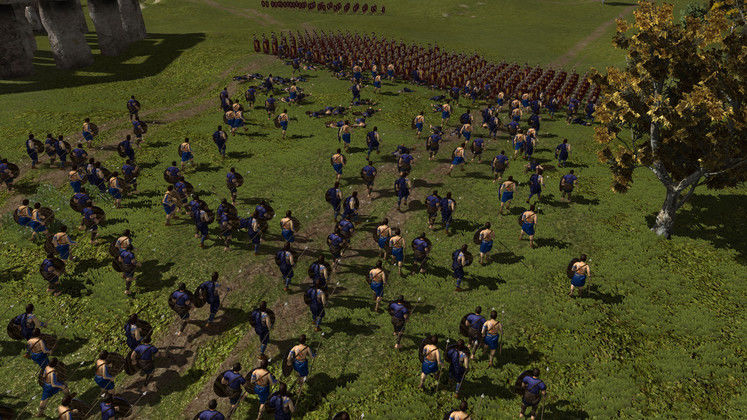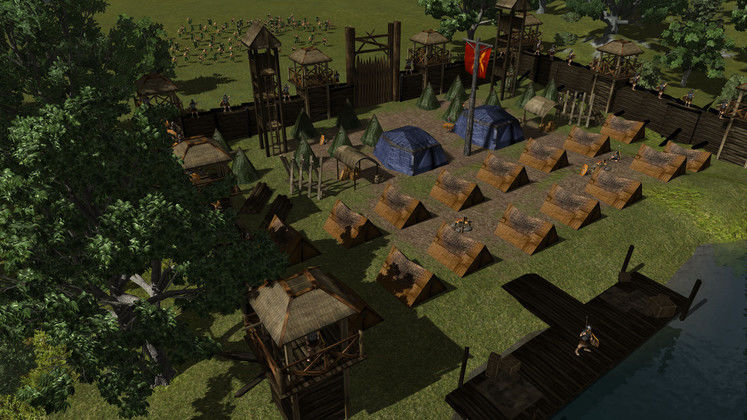It's a clever system that avoids the clumsy disconnect between combat and a clunky tactical map that plagued Rome II. Here you've got total control, but also the smoothness of being able to respond instantly to developments on any scale. There's no stopping and starting, no waiting for loading screens or enemy turns. Just the grand plan. Or lack of it. If only the RTS combat held up its side of the bargain.
 |
| Roman legionaries can ruin any attacker's day if they aren't very, very careful |
For a game about Julius Caesar, one of the pre-eminent battlefield geniuses of his day, it's a shame that Hegemony doesn't do the old ultraviolence particularly well. Expect very basic RTS fare, with most battles inevitably coming down to dry numbers rather than being decided by tactical trickery. The business of organising your force into an efficient formation is too clunky, lacking the clarity of, say, Total War's drag and drop approach. It doesn't help that terrain tends to be very confined, without any wide open spaces to give you space when setting up your force. You can cycle between certain stances for some units, Roman legionaries can be ordered to close ranks defensively to protect against charging tribesmen for example, but by and large there's little reason or opportunity to play around with these options; ultimately you'll find yourself using the patented 'march the strongest units right into the middle of the enemy army' approach.
There's still a basic satisfaction to be found in massacring scores of the enemy with your elite troops, or crushing helpless infantry with a cavalry charge, but it's a much less cinematic and deep affair than I'd hoped for. I wasn't expecting Hollywood battles given the massive discrepancies in budget compared to similar war gaming titles, but a little more finesse wouldn't have gone amiss. The campaign fares slightly better than sandbox mode thanks to regular scripted battles that make sure you've got more space to manoeuvre, but you still never really feel you're triumphing over an enemy with quick thinking tactics. Enemy AI can also be somewhat suspect, with enemy generals too eager to crash their troops directly into your line without waiting for the right opportunity.
To be fair, Hegemony isn't trying to ape the epic flourishes of Total War. While that series glories in the spectacle, the dust and blood and clash of war, Hegemony Rome is really a game about infrastructure and force organisation. The logistics and ruthless precision of a well-planned military campaign. Forget marching thousands upon thousands of men deep into enemy territory without a care in the world, first you need to make sure that army is fed, well-supplied and not thinking of scampering off into the woods the moment your back is turned.
 |
| You can swoop down from this strategic overview to anywhere on that map |
Not that Hegemony makes taking care of your troops overly complex. Each of your provinces typically has a couple of farms or mines which need to be tended to by your civilian workers, or more fittingly by slaves captured on your campaign. Once you've got these structures working, you can set up supply chains between various outposts camps and cities from your bread-basket towns directly to the front line. A simple idea, essential to victory but thankfully easy to get to grips with. In fact the game in general finds a nice balance between complexity and ease of play; there's definitely enough to think about that you're always kept on your toes, but it never has you spinning so many plates that you're overwhelmed.
It could do with a better UI to keep those pieces straight in your head, though. Once you've conquered a good portion of the map it's increasingly difficult to remember exactly how everything connects together. One unit of beardy German berserkers behind your lines can take out a single farm, which in turn causes a domino effect on the supply lines several provinces away. Suddenly your front-line troops are eating each others feet, your morale is shot to balls, and every city from Geneva to Calais is revolting. All of which is fine, because as I said before this is a game that's all about the importance of strategy and logistics, but it would be handy if there was some kind of supply line map you could bring up that lets you know where you're being affected at a single glance. As is, it can get quite frustrating when you're trying to out exactly why your grand push into Gaul is coming apart at the seams.
The four-part campaign is designed to gently ease you into the game, teaching you the core systems one by one and slowly ramping up the stakes with each chapter. Based on Caesar's actual diaries of the Gaul campaign, it starts with his dismantling of the tribes at Bibracte and ends with his troops crossing the Rubicon back to Rome, taking you through various skirmishes, battles and periods of fortification and construction along the way. As far as gameplay goes there's nothing especially different here aside from those scripted battle sequences described earlier, but there is an impressive historicity to the story. Each town and settlement gets its own historical background blurb, and those interested in ancient history will get a kick out of retracing Big Julius' steps.
 |
| Romans can build all sorts of awesome fortifications like this. Gallic tribes... can't. But they can recruit fresh troops more easily, and have better facial hair |
Once you’ve mastered the game's various intricacies via the campaign, you'll feel more comfortable diving in to the open sandbox mode, which puts you in charge of whatever faction you fancy and lets you decide for yourself how to conquer Gaul. Playing a Gallic, Germanic or Belgic tribe is a little harder to get the hang of than the Roman army, lacking as they do much of the advanced infrastructure and skills their conquerors used so effectively; they get various bonuses instead, like faster recruitment rates and the ability to scavenge food from the forest. While you can do some glad-handing, unfortunately diplomacy tends to boil down to bribing other tribes into allying with you, which lessens the variety of each fresh game a little. Still, it's nice to be able to turn the tables on those sandal-wearing interferers for once. With a few different skirmish maps of varying size and that meaty campaign, there's more than enough content here to keep you occupied.
HEGEMONY ROME: THE RISE OF CAESAR VERDICT
Hegemony Rome’s quick, neat and easy approach to grand strategy puts impressive control in the player’s hands. The seamless and easy to navigate tactical map is a real strength, one that similar war games could do with taking note of. That said, despite commendable scope and some neat ideas, the meat and potatoes combat system and issues with the interface and AI decision-making slightly bog down the overall package. Even with those flaws it’s a game that tries, and occasionally accomplishes, things that no other strategy games attempt. Far from perfect, but worth your time if you’re looking for a historical war game with a bit of a difference.
TOP GAME MOMENT
Popping up to the grand strategic view, realising my elite legions were getting repeatedly kicked up the arse by irritable Suebi tribesmen, then zooming down to the battlefield from on high to save the day.




